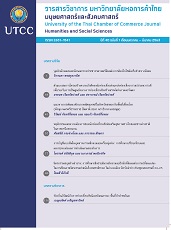บุคลิกลักษณะและลักษณะทางประชากรศาสตร์มีผลต่อการติดเว็บไซต์เครือข่ายทางสังคม
Main Article Content
บทคัดย่อ
งานวิจัยนี้มีวัตถุประสงค์เพื่อศึกษาอิทธิพลของบุคลิกลักษณะและลักษณะทางประชากรศาสตร์ที่มีผลต่อการติดเว็บไซต์เครือข่ายทางสังคม การวิจัยนี้เป็นการวิจัยเชิงสำรวจโดยมีการเก็บข้อมูลแบบตัดขวางเพื่อศึกษาการติดเว็บไซต์เครือข่ายทางสังคม โดยการเก็บข้อมูลเป็นแบบเจาะจงในกลุ่มผู้ใช้เว็บไซต์เครือข่ายทางสังคม ผู้เข้าร่วมการวิจัยนี้มีจำนวนทั้งหมด 460 คน ผลการวิจัยพบว่า กลุ่มผู้มีบุคลิกลักษณะชอบแสดงออก มีแนวโน้มในการติดเว็บไซต์เครือข่ายทางสังคม ส่วนกลุ่มที่มีความมั่นคงทางอารมณ์และมีสติตระหนักรู้ มีแนวโน้มที่จะไม่ติดเว็บไซต์เครือข่ายทางสังคม นอกจากนั้น ผลวิจัยยังพบว่ากลุ่มที่มีอายุน้อยจะมีแนวโน้มในการติดเว็บไซต์เครือข่ายทางสังคมมากกว่ากลุ่มที่มีอายุมาก การศึกษานี้ไม่พบความแตกต่างระหว่างเพศและการติดเว็บไซต์เครือข่ายทางสังคม
Article Details
ลิขสิทธิ์ของบทความ
ผลงานที่ได้รับการตีพิมพ์ถือเป็นลิขสิทธิ์ของมหาวิทยาลัยหอการค้าไทย ห้ามมิให้นำเนื้อหา ทัศนะ หรือข้อคิดเห็นใด ๆ ของผลงานไปทำซ้ำ ดัดแปลง หรือเผยแพร่ ไม่ว่าทั้งหมดหรือบางส่วนโดยไม่ได้รับอนุญาตเป็นลายลักษณ์อักษรจากมหาวิทยาลัยหอการค้าไทยก่อน
เอกสารอ้างอิง
Amichai-Hamburger, Y., & Vinizsky, G. (2010). Social network use and personality. Computers in Human Behavior, 26, 1289-1295.
Andreassen, C. S., Torsheim, T., Brunborg, G. S., & Pallesen, S. (2012). Development of a Facebook addiction scale. Psychological Reports, 110, 501-517.
Baek, K., Holton, A., Harp, D., & Yasschur, C. (2011). The links that bind: Uncovering novel motivations for linking on Facebook. Computers in Human Behavior, 27, 2243-2248.
Blachnio, A., Przepiorka, A., & Pantic, I. (2016). Association between Facebook addiction,
self-esteem and life satisfaction: A cross-sectional study. Computers in Human Behavior, 55, 701-705.
Correa, T., Hinsley, A. W., & de Zúñiga, H. G. (2010). Who interacts on the web? The
intersection of users’ personality and social media use. Computers in Human Behavior, 26, 247–253.
Costa, P. T., & McCrae, R. R. (1995). Primary traits of Eysenck’s P-E-N system: Three-and five-factor solutions. Journal of Personality and Social Psychology, 69, 308-317.
Dumrongsiri, N., & Pornsakulvanich, V. (2008). SMS motives predicting SMS use and
attitudes toward SMS advertising: The evidence from Thailand. Paper presented at the Annual Meeting of the International Communication Association, Montreal, Canada.
Dumrongsiri, N., & Pornsakulvanich, V. (2010). Social networking sites in Thailand:
Motives and predictors of university students’ behaviors. International Journal of Innovation and Learning, 8(4), 427-444.
Dumrongsiri, N., & Pornsakulvanich, V. (2012). Media and social influences on the use of social networking sites in Thailand. Journal of Communication Arts, 30(2), 84-100.
Electronic Transaction Development Agency (2018). Thailand internet user profile. Retrieved August 29, 2019, from https://www.etda.or.th/publishing-detail/thailand-internet-user-profile-2018.html
Goldberg, L. R. (1993). The structure of phenotypic personality traits. American Psychologist, 48, 26-34.
Hong, F., Huang, D., Lin, H., & Chiu, S. (2014). Analysis of the psychological traits, Facebook usage, and Facebook addiction of Taiwanese university students. Telematics and Informatics, 31, 597-606.
Hughes, D. J., Rowe, M., Batey, M., & Lee, A. (2012). A tale of two sites: Twitter vs Facebook and the personality predictors of social media usage. Computers in Human Behavior, 28(2), 561-569.
Internet World Stats (2016). Asia internet use, population data and Facebook statistics. Retrieved August 29, 2019, from https://www.internetworldstats.com/stats3.htm#asia.
Internet World Stats (2019). Asia internet use, population data and Facebook statistics. Retrieved August 29, 2019, from https://www.internetworldstats.com/stats3.htm#asia
Judge, T. A., Heller, D., & Mount, M. K. (2002). Five-factor model of personality and job satisfaction: A meta-analysis. Journal of Applied Psychology, 87, 530-541.
Krämer, N. C., & Winter, S. (2008). Impression management 2.0: The relationship of self-esteem, extraversion, self-efficacy, and self-presentation within social networking sites. Journal of Media Psychology, 20, 106-116.
McCrae, R. R., & Costa, P. T. (1989). The structure of interpersonal traits: Wiggins’s circumplex and the five-factor model. Journal of Personality and Social Psychology, 56, 586-595.
Moore, K., & McElroy, J. C. (2012). The influence of personality on Facebook usage, wall postings, and regret. Computers in Human Behavior, 28, 267-274.
Perrin, A. (2015). Social media usage: 2005-2015. Retrieved August 29, 2019, from
https://www.pewinternet.org/2015/10/08/social-networking-usage-2005-2015.
Pornsakulvanich, V. (2008). Internet addiction, individual differences, and well-being among Thai students in a private university. Association of Private Higher Education Institutions of Thailand Journal, 18(2), 1-17.
Pornsakulvanich, V. (2017a). Influences of individual differences, internet communication motives, and internet usage on social well-being and satisfaction. University of Thai Chamber of Commerce Journal, 37(2), 1-16.
Pornsakulvanich, V. (2017b). Personality, attitudes, social influences, and social networking site usaged online social support. Computers in Human Behavior, 76, 255-262. doi:10.1016/j.chb.2017.07.021
Pornsakulvanich, V. (2018). Excessive use of Facebook: The influence of self-monitoring and Facebook usage on social support. Kasetsart Journal of Social Science, 39(3). doi:10.1016/j.kjss.2017.02.001
Pornsakulvanich, V., & Dumrongsiri, N. (2010). Attitude and social influence predicting the intention to blog in Thailand. NIDA Development Journal, 50(2), 71-87.
Pornsakulvanich, V., & Dumrongsiri, N. (2012). Personality traits and demographic profile predicting social networking sites usage in Thailand. In Proceedings at Asian Conference on Media and Mass Communication (pp. 50-60). Osaka, Japan: n.p.
Pornsakulvanich, V., & Dumrongsiri, N. (2013). Internal and external influences on social networking sites usage in Thailand. Computers in Human Behavior, 29(6), 2788-2795.
Pornsakulvanich, V., Dumrongsiri, N., Sajampun, P., Sornsri, S., John, S, P., Sriyabhand, T., & Jiradilok, S. (2012). An analysis of personality traits and learning styles as predictors of academic performance. ABAC Journal, 32(3), 1-19.
Pornsakulvanich, V., Haridakis, P. M., & Rubin, A. M. (2008). The influence of dispositions and internet motivation on online communication satisfaction and relationship closeness. Computers in Human Behavior, 24(5), 2292-2310.
Ross, C., Orr, E. S., Sisic, M., Arseneault, J. M., Simmering, M. G., & Orr, R. R. (2009). Personality and motivations associated with Facebook use. Computers in Human Behavior, 25, 578-586.
Ryan, T., & Xenos, S. (2011). Who uses Facebook? An investigation into the relationship between the big five, shyness, narcissism, loneliness, and Facebook usage. Computers in Human Behavior, 27, 1658-1664.
Saucier, G. (1994). Mini-markers: A brief version of Goldberg’s unipolar big-five markers. Journal of Personality Assessment, 63, 506-516.
Tang, J. H., Chen, M. H., Yang, H. Y., Chung, T. Y., & Lee, Y. A. (2015). Personality traits, interpersonal relationships, online social support, and Facebook addiction. Telematics and Informatics, 33(1), 102-108.
Wilson, K., Fornasier, S., & White, K. M. (2010). Psychological predictors of young adults’ use of social networking sites. Cyberpsychology, Behavior, and Social Networking, 13, 173-177.
Young, K. S. (1998). Internet addiction: The emergence of a new clinical disorder. CyberPsychology & Behavior, 1, 237-244.
Young, K. S. (2009). Internet addiction: Diagnosis and treatment considerations. Journal of Contemporary Psychotherapy, 39(4), 241-246.
Zikmund, W. G. (2003). Business research methods (7th ed.). Mason, OH: South-Western Thomson.


